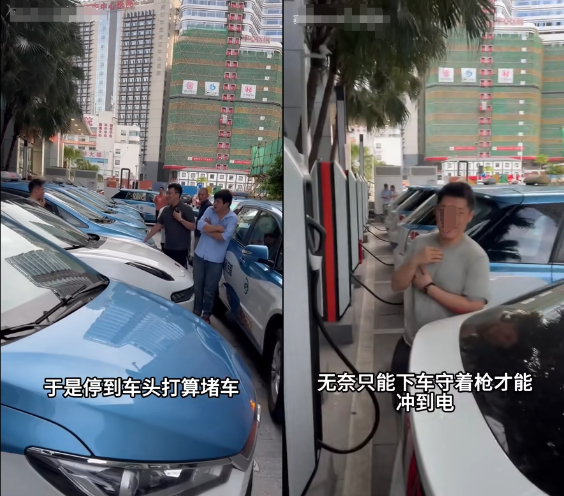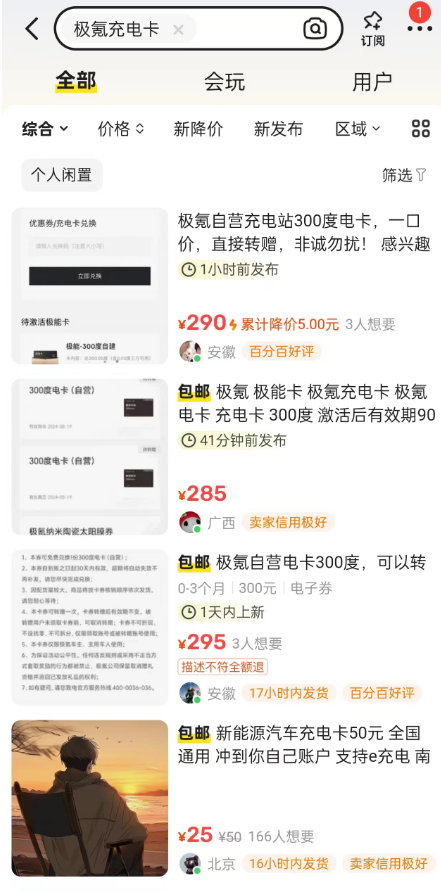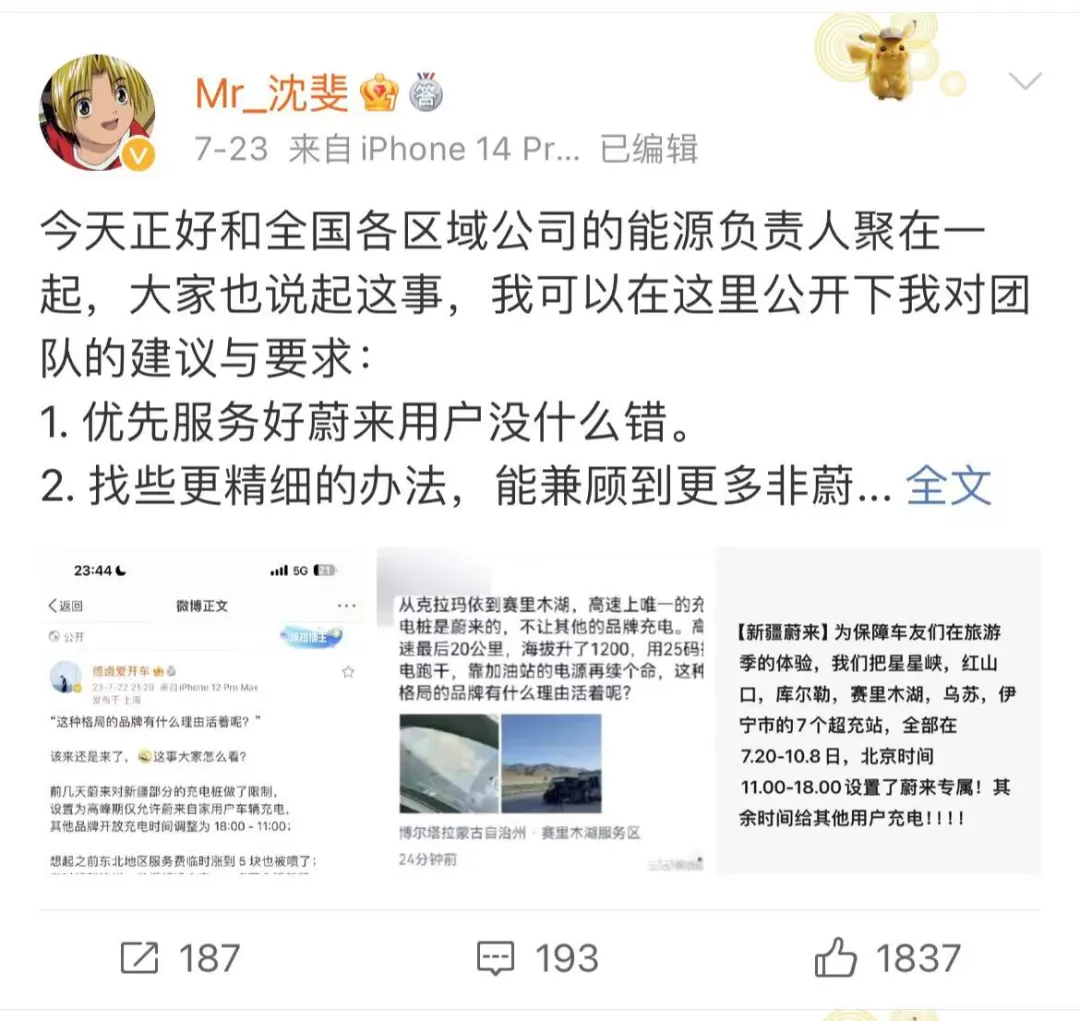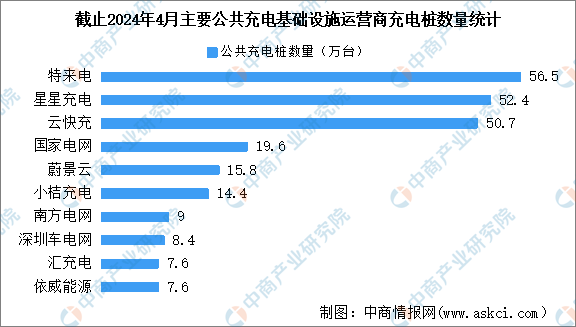ZEEKR Charging Stations Fully Open: Prioritize Profit or Owner Experience?
![]() 07/25 2024
07/25 2024
![]() 374
374
What? BYD Owners Occupy ZEEKR Charging Stations
Owners not protected by automakers are seeing their charging piles taken over by "outsiders".
On July 15, ZEEKR released specifications for the proper use of charging station ground locks, emphasizing that ZEEKR charging stations are open to owners of all brands of new energy vehicles. Owners of new energy vehicles can quickly lower the ground locks and enjoy convenient charging services through the ZEEKR App or the ZEEKR Energy Mini Program following the in-station guidance.

Image Source: ZEEKR
This statement is both a reiteration of ZEEKR's openness of its charging stations and a warning to a recent incident where a NIO owner forcibly entered a ZEEKR Supercharger station against the ground lock.
However, for some ZEEKR owners, this non-committal announcement from ZEEKR is far from satisfactory. Prior to this incident, their once smooth charging experience had already been disrupted by owners of other brands, with some ZEEKR owners even unable to charge at ZEEKR charging stations.
So, what have ZEEKR owners experienced that leads to so many complaints? How do other automakers enhance the refueling experience for their consumers? What problems do domestic automakers that build their own charging piles encounter currently?
01
ZEEKR Charging Station: A "Battlefield" for ZEEKR Owners vs. Ride-hailing Drivers?
ZEEKR's time-consuming and labor-intensive charging stations have become a gathering place for taxi and ride-hailing drivers.
Recently, a blogger posted a video stating, "ZEEKR charging stations are open to all brands, and the nightmare for ZEEKR owners has arrived." As an owner who spent over 500,000 yuan on a ZEEKR 009, he is extremely dissatisfied with ZEEKR's charging services.
Specifically, after ZEEKR opened its charging stations, many BYD and other brand owners flocked in, leaving ZEEKR owners with nowhere to charge at their own stations.
There have even been cases of BYD ride-hailing and taxi owners "bullying" ZEEKR owners. Several BYD owners claimed that ZEEKR owners cut in line while parking, so they parked in front of them, intending to block the ZEEKR cars from charging. They repeatedly unplugged the charging cables, forcing the ZEEKR owners to guard the charging guns to charge, and even opened their car doors without permission.

Image Source: Bilibili UP Lead Racer Kimi
In the comments section, many ZEEKR owners also expressed that this was not just the blogger's feeling; they too had similar experiences, some more severe than others. Other brands occupying ZEEKR charging stations and making them queue up for charging was still orderly, but there were also cases of many Lalamove or other brand MPVs occupying two or even three charging spots while no one was around, and posted numerous images of ZEEKR charging stations being "occupied" and some owners parking disorderly for charging.

Image Source: Bilibili user comments
ZEEKR owners also called in the comments section for higher charging fees or restricted access policies for new energy vehicles of other brands that are encroaching on ZEEKR owners' rights.
But some owners said that the current ZEEKR charging benefits are already being sold like hotcakes on Xianyu, and unless the owners are required to authenticate their accounts and undergo facial recognition every time they charge, allowing them to use the benefits, a group of long-term sellers of ZEEKR benefits would be unhappy.

Image Source: Xianyu Screenshot
The comments section was bustling with activity, with some discussing how to ensure ZEEKR owners' charging rights by setting charging prices, adjusting charging times, or designating exclusive parking spaces, while others sarcastically commented on BYD's "Together" slogan, implying that BYD, with such large sales, is unwilling to invest in building public charging piles. There were also many owners selling ZEEKR charging benefits mixed in.
In fact, the debate over whether to allow owners of other brands to use their own charging piles occurred with NIO a year ago.
Last July, NIO Xinjiang announced that to ensure the experience of car owners during the tourist season, from July 20 to October 8, seven supercharger stations in Xingxingxia, Hongshankou, Korla, Sayram Lake Wusu, and Yining would be designated as exclusive for NIO owners, with other brand owners allowed to charge at other times.
Logically, it is understandable for a brand to prioritize the charging rights of its own owners and not completely ban other brand owners from charging, but even so, some owners expressed dissatisfaction.
A non-NIO owner said on social media, "From Karamay to Sayram Lake, the only charging pile on the highway is NIO's, and it doesn't allow other brands to charge. The last 20 kilometers of the highway, with an altitude increase of 1,200 meters, I ran out of electricity at 25 km/h and had to rely on the power supply at the gas station to keep going. What reason does such a brand with such a small mindset have to exist?"
NIO Vice President Shen Fei quickly responded, saying, "It's not wrong to prioritize serving NIO users, but currently, a one-size-fits-all time restriction is not the best approach. I suggest that our team optimize and find more nuanced solutions that can accommodate more non-NIO users."

Image Source: Shen Fei's Weibo Screenshot
Furthermore, Shen Fei suggested that if other automakers have a large number of vehicles but are not planning to build charging piles, perhaps those brands could subsidize NIO for its charging services, so that one brand doesn't have to bear the enormous construction pressure alone.
In similar situations, one actively safeguards users, while the other remains silent. On the surface, it appears to be a difference in automakers' concern for owners and satisfaction of user experience, but behind it lies a distinction in the business models of the two automakers.
02
If ZEEKR Doesn't Stand by Its Owners Now, Will Future Owners Still Buy ZEEKR?
Perhaps ZEEKR is not blind to the voices of its users. However, under the immense pressure of charging pile costs, opening charging stations has almost become the only option.
In terms of charging station construction costs, data shows that taking State Grid's 150kw charging pile as an example, the complete construction cost of a single pile exceeds 130,000 yuan, and the cost of automakers building their own higher-power supercharger piles is even more daunting, leading to a relatively small number of automakers choosing to build their own piles and mostly going down the path of openness.
Take NIO, for example, as the most active new force automaker in investing in charging/swapping stations, NIO is undoubtedly the most open automaker in the industry, allowing any brand of electric vehicle to charge at its charging stations as long as there are no technical issues. This has greatly increased the utilization rate of its charging/swapping stations, making it one of the highest in the industry.
From a data perspective, according to NIO NIO Power Day 2023, the proportion of charging for NIO, BYD, and Tesla brand users reached 20.3%, 19.2%, and 13.1%, respectively, while Geely (4.1%), Roewe (4.1%), Xpeng (3.5%), Lixiang (3.5%), Changan (3.2%), Beijing Automotive Group (2.8%), and Aion (2.6%) ranked 4th to 10th. Logically, with so many other brand owners coming to charge, NIO's charging stations should be the closest to profitability in the industry.
But reality is not so simple. The construction of energy replenishment infrastructure is like a bottomless pit that swallows up automakers' cash flow, and even NIO cannot withstand the enormous expenses. In addition to the hardware costs of building charging/swapping stations, there are also operational expenses such as personnel on duty, site leasing, and commercial electricity bills.
Adhering to the principle that the wool comes from the sheep, NIO also adjusted owner benefits a year ago, eliminating the benefit of free battery swaps.
As a battery swapping player, NIO has a natural advantage in ensuring its own users' refueling experience, as opening charging rights to other new energy vehicle brands does not significantly impact NIO owners' battery swapping experience. However, for other automakers, how to open charging stations becomes a matter of study.
For automakers that prioritize only the user experience, they can follow Tesla's example and set high prices to discourage owners of other brands and ride-hailing drivers, naturally achieving the goal of "clearing the field" at their own charging stations. However, such high charging prices will also discourage many of their own users. While this enhances the user's refueling experience to a certain extent, it is hardly comprehensive.
To go further, automakers can learn from Xpeng by setting prices 0.3 to 0.5 yuan higher than those of third-party charging stations like BitCharge and then reducing costs through benefits such as electricity cards and积分购买服务折扣券, thus solving the problem of Xpeng owners' refueling experience. However, this approach has the same drawbacks as Tesla's: if a charging station discourages taxi, Lalamove, ride-hailing, and other brand owners, it is almost a foregone conclusion that the station will not be profitable.
For automakers that still want to profit or reduce losses through charging stations, they naturally cannot refuse new energy vehicles of other brands from charging, and ZEEKR is one of them.
ZEEKR has acquired more "charging users" by offering lower prices and stable services compared to its competitors, which helps spread out the costs of building and operating charging stations. On paper, this provides significant support for the "long-term" development of the charging business.
However, embracing all brand owners wholeheartedly is also a double-edged sword. Such a large influx of external owners into ZEEKR charging stations can quickly deteriorate the refueling experience for branded customers if not well-managed. In the worst case, it can even indirectly discourage potential customers from buying ZEEKR, which goes against the original intention of "building exclusive ZEEKR charging stations to enhance user experience and attract customers to buy."
Whether it's a win-win situation of "increased car sales + improved charging experience" or a lose-lose situation of "little profit from charging + poor owner experience discouraging potential owners" ultimately depends on ZEEKR's business choices and wisdom.
Of course, this situation is not unsolvable. Raising charging prices for non-ZEEKR owners during peak hours and mandating that one-third or even half of the charging piles be reserved exclusively for ZEEKR owners are direct ways to improve the refueling experience for ZEEKR owners. However, currently, ZEEKR has not made any relevant changes, and perhaps it will truly need to wait until the brand "puts owners at heart."
03
Closing Thoughts
As of April 2024, the number of charging piles operated by charging operation enterprises nationwide reached 2.977 million, with the top 10 operators accounting for a combined 2.42 million charging piles, or 81.3% of the total.

Image Source: AskCI
Compared to these third-party enterprises specializing in the energy replenishment industry, the number of charging piles built by automakers is indeed too small. Even NIO, known as the "infrastructure maniac" with the largest number of charging piles, has only 22,822, a "small" volume that, when combined with operating costs, makes profitability seem far off.
Therefore, the only driving force supporting these automakers is to provide better energy replenishment services as a supporting service for their own owners, and some electric vehicle brands that prioritize profit over user experience are essentially putting the cart before the horse.
After all, when owners of a brand that touts itself as a "high-end" electric vehicle cannot even get a normal refueling experience at their own charging stations and may even be "bullied" by other owners, it is undoubtedly a great irony to the brand's high-end positioning and a significant lack of brand experience.
References:
1. "So, If There Aren't Enough Charging Stations for Our Own Owners, Should We Limit Access to Other Brands?", Kanshangche;
2. "What Benefits Will Automakers Gain by Opening Up Their Self-Built Charging Piles?", Qingbaojiaodao;
3. "ZEEKR Opens Charging Stations to All Brand Owners", Diandongzhijia;
4. "NIO Releases User Charging Report for May Day Holiday: 80% of Charging Users Are from Other Brands!", Jifengqihou.








